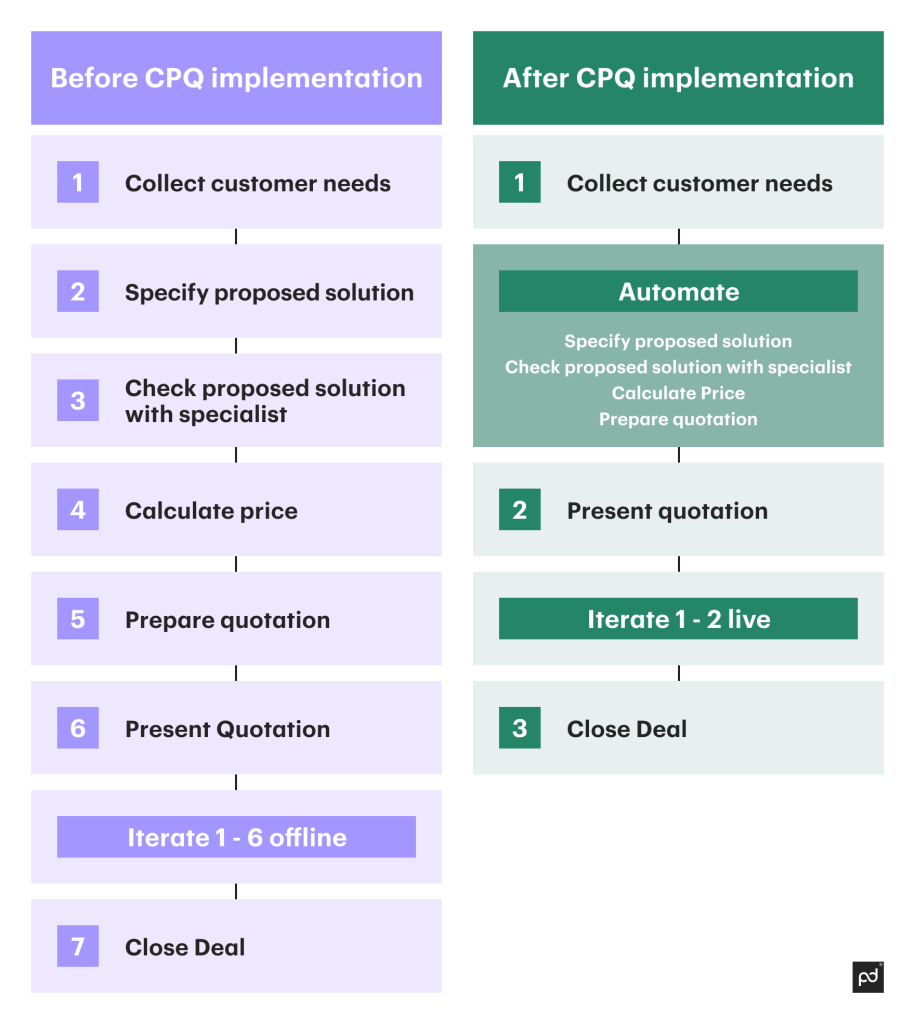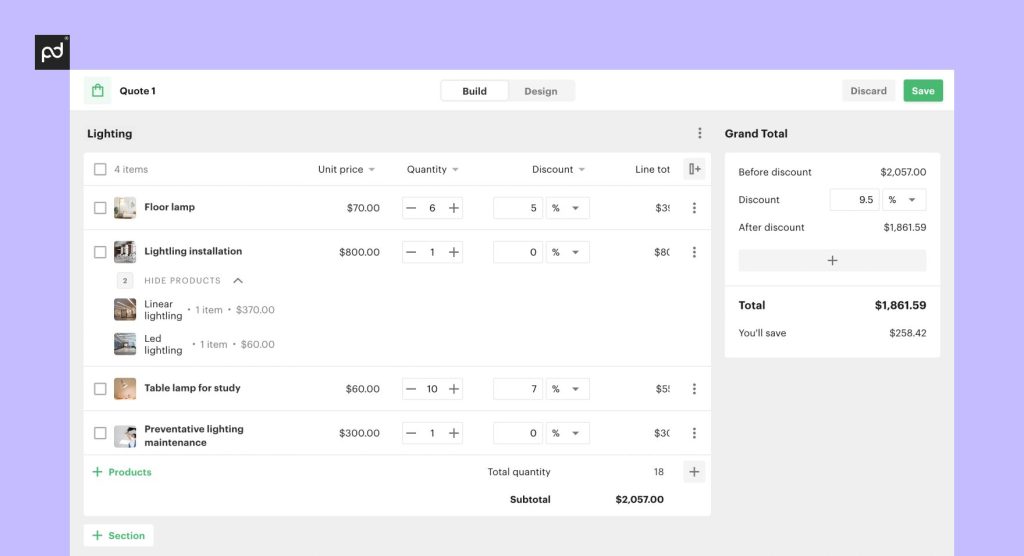If you sell complex, configurable products online, you will almost inevitably come to the realization one day that you need to add a CPQ tool to your software toolkit.
This article covers the basics of CPQ implementation and guides you in the right direction on your journey toward more efficient sales.
Key takeaways
- CPQ is a must-have for selling complex, configurable products
- CPQ implementation helps shorten sales cycles, minimize the number of pricing and configuration errors, and dramatically improve the customer experience
- Modern CPQs can be integrated with the majority of ERP/CRM systems in a relatively easy way
- The key to choosing the right CPQ solution is a thorough assessment of your product portfolio, sales process, and software environment, and then matching the result to the capabilities of particular solutions
- A perfect CPQ solution is one that requires minimal time to implement, causes the least disruption in your day-to-day operation, and is scalable enough to address your future needs
What is configure-price-quote?
Configure-price-quote (or CPQ for short) is a category of software tools that help companies generate sales quotes for complex products much faster and with a higher degree of accuracy.
Complex or configurable products are products that can consist of one or several base components and an arbitrary number of additional elements that may be incompatible with each other or require extra components to work together.
This compatibility logic, mutual dependencies, discounting rules, and other parameters can be defined once to enable sales reps or even customers to configure products online and instantly see the effect of their choices on price, availability of options, assembly/delivery time, and much more.
Now, let’s see how CPQ can be part of your sales process.
What is CPQ implementation?
There isn’t a single CPQ tool that exists in isolation. As a rule, CPQ solutions are integrated with corporate ERP (Enterprise Resource Planning), PIM (Product Information Management), and CRM (Customer Relationship Management) systems for exchanging product and client data.
Furthermore, they can also talk to your accounting and tax software, your eCommerce website, and even more systems, depending on what you sell and what your manufacturing and sales processes look like.
Some tools are more self-sufficient and tend to import a lot of product/customer data into their own cloud, while other CPQ solutions rely primarily on fast and seamless integrations with CRM/ERP systems within the same interface.
In the most general terms, CPQ implementation is the process of embedding CPQ software into your sales pipeline and your software environment with the purpose of replacing some of their least efficient and time-consuming elements.

CPQ implementation is a process that often requires a drastic overhaul of your sales practices and takes anywhere between weeks and many months to complete, depending on the system and complexity of your products.
The payoff is more than worth it.
As a result, you fully delegate product configuration to a specialized piece of software that returns a set of artifacts that can be presented to the customer and/or used for manufacturing, including a quote or proposal, bill of materials, sales order, and more.
Furthermore, anything you can initiate that helps sales and marketing work together smarter and faster is always a good thing, right?
Let’s find out the basic steps you’ll take to succeed with your CPQ implementation.
Successful CPQ implementation — how to do it right
Just like with any other type of business software, your quest starts with defining your needs and goals.
Don’t limit yourself to the current situation — think about the requirements you’ll have in a year or three years from now and how the CPQ software will be able to address them by scaling and adapting to what you have planned for it.
Here’s a pre-departure checklist to make sure you don’t miss anything!
Make every voice heard
Since any CPQ software is essentially cross-departmental, make sure that your list of requirements goes beyond just the functional ones.
For example, your legal and accounting teams may be interested to know how this automation will enhance your standard sales process — as well as what kind of risks or changes they may be facing in the wake of CPQ implementation.
Make sure to capture their points of concern and include them in your requirements.
Do your research
Start with researching the CPQ software market and narrow your choice down to a handful of products that best fit your industry and product portfolio.
You don’t need an expensive, industrial-grade CPQ for selling kitchen cabinets, so pay attention to the positioning of each product and its intended target audience to avoid overpaying for what you won’t really use.
Talk with potential vendors
Document your requirements and send them to pre-selected vendors along with a demo request.
Insist on live online demos to assess the functionality of the proposed solutions and their fitness for your needs.
Make sure to inquire about the expected support and maintenance period, as you don’t want to find yourself in a situation with a discontinued product a mere six months after product adoption.
Integrate your new software
Purchase the selected CPQ software and integrate it with the rest of your tools.
Some solutions will be very easy to integrate, while others may require substantial efforts and even custom development to help the dots connect — which will entail additional expenditures as well as time to get up and running.
Set up your products and rules
It’s now time to start configuring your products in the CPQ, and set up bulk discount rules, dependencies, limitations, and prices along with the rest of the business logic.
These include (but are certainly not limited to) the following:
- Product catalog search filters: Facilitates efficient product retrieval in large catalogs.
- Pricing table & discounts: Displays pricing structures and allows for discount applications.
- Quote line groups: Organizes products into categories for grouped parameter application.
- Conditional fields: Implements rules-based configurations for dynamic quoting.
- Dashboard & reporting: Offers insights and analytics for performance tracking and decision-making.
These and many other CPQ features can be expanded upon to suit the needs of you and your team.
One example: The ability to add conditional fields to the business logic of your sales process opens a slew of product configuration scenarios for you — you can make certain upgrades available only if a particular component is selected or apply a discount when the combined cost of a product exceeds a particular value.

Mistakes to avoid when implementing CPQ
Although mistakes are virtually unavoidable, following these simple rules should help you steer clear of the most common pitfalls:
- Do not underestimate training needs. Implementing CPQ software requires proper instruction. Skipping comprehensive user training can lead to underutilization and ineffective use of the software’s full potential.
- Do not ignore data quality. Poor quality or inaccurate data can hinder CPQ functionality, causing flawed configurations and incorrect quotes, potentially damaging customer relationships.
- Do not ignore the importance of post-implementation review. Failure to review and refine processes after the implementation phase can result in persistent inefficiencies and limit the software’s benefits.
Start your sales automation journey with PandaDoc
The benefits of using CPQ are fairly self-evident. If you are interested in learning more about the principles of CPQ-based selling, consider PandaDoc.
Our solutions combine the ease of quote generation with unparalleled document management capabilities, including document status tracking, eSigning, and secure payments.
Request a free demo today or go ahead and sign up for a 14-day trial for a more practical familiarization with our platform.
Disclaimer
PandaDoc is not a law firm, or a substitute for an attorney or law firm. This page is not intended to and does not provide legal advice. Should you have legal questions on the validity of e-signatures or digital signatures and the enforceability thereof, please consult with an attorney or law firm. Use of PandaDoc services are governed by our Terms of Use and Privacy Policy.


